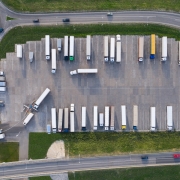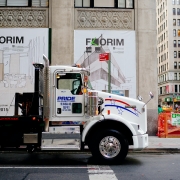
Onboarding is one of the most important parts of the recruiting process. It can convince a new driver to stay on the team for the next decade, or it can send them packing before their first shift begins.
An effective onboarding process sets the tone for the entire driver experience, from the moment they’re hired to the long haul ahead. In a career like truck driving, the onboarding process is especially important to cover safety regulations, how to manage equipment, and the relationships between dispatch, management, and drivers.
Wondering how to implement innovative onboarding techniques that engage truck drivers of all experience levels? Keep reading to find out what strategies to keep in mind to streamline your onboarding process and set your drivers up for success.
Clear Communication is Key
An effective onboarding process establishes clear communication channels from the start. Different drivers may prefer different methods of contact, so it helps to offer various channels such as phone calls, emails, text messages, and instant messaging apps.
Some companies encourage communication by assigning a dedicated contact person to each driver. This personalized approach fosters trust and encourages open communication to address any questions or concerns drivers have throughout the process.
Regular updates are essential to keep drivers informed about any changes or updates relevant to their role, and to ensure new hires feel quickly integrated into company culture. Frequent touchpoints also demonstrate transparency and help drivers stay engaged and prepared.
It’s important to remember that communication goes both ways. This is why implementing feedback mechanisms, such as engagement surveys, suggestion boxes, or one-one-one meetings, shows drivers that their opinions are valued and can lead to improvements in communication and onboarding processes.
Invest in Technology
Integrating modern technology solutions is one of the best methods to streamline the onboarding process and make it easier for both drivers and employers. Reducing the time a driver spends completing the hiring and onboarding processes can have immediate payoffs by improving employee satisfaction and decreasing driver turnover.
Manual paperwork is time-consuming and error-prone, and often results in drivers needing to rewrite the same information over and over. By implementing electronic document management systems, essential information can be gathered more efficiently and easily stored and retrieved.
Applicant tracking systems also help to organize the onboarding process by centralizing important data and ensuring that each driver completes the required steps efficiently and effectively. These systems automate tasks such as collecting applicant information to repopulate other forms, saving drivers time and effort.
Along with diminishing the time drivers spend filling out redundant data, applicant tracking systems can assist with scheduling interviews and conducting background checks, helping to streamline the hiring process and ensure compliance with hiring regulations.
Another way technology can improve the onboarding process is by creating mobile-friendly options to submit and sign important documents, access digital training materials, and communicate with HR or mentors.
A digital onboarding portal can provide new hires with centralized access to interactive training modules, orientation videos, company policies, and onboarding checklists in a structured and user-friendly platform. The flexibility of remote onboarding and training will also attract busy drivers that value completing essential onboarding tasks at their own pace and schedule.
Consider Mentor Programs
A proven strategy to increase driver retention rates and foster a culture of support and continuous learning is through offering mentor or buddy programs. These work by pairing new hires with seasoned drivers to provide insights and career advice, even beyond the onboarding process.
Mentors can share practical tips, best safety practices, and real-world insights that may not be covered in formal training programs, while helping new drivers quickly integrate into the company’s culture.
The various processes and paperwork required throughout onboarding can often feel repetitive and impersonal, but mentor programs demonstrate that a company is invested in their employees and their success. Feeling welcomed and connected to a company from the start can increase driver retention and engagement while creating a work environment of communication and support.
Create a Cohesive Onboarding Checklist
A disorganized recruiting and onboarding process doesn’t just waste time and money, it can also result in dissatisfied drivers that will increase your turnover rates.
By having a structured checklist for the onboarding process, employers ensure that no important steps are missed and that every driver has a smooth introduction to the company. A checklist also helps employers avoid delays in processing and allows HR to track the progress of every new driver.
Since onboarding can be a complex process with multiple steps, a checklist breaks down each step into manageable tasks, providing clear guidance to both the employer and the new hire on what needs to be done and in what order. Additionally, a checklist helps to standardize the onboarding process across all new hires, ensuring consistency and fairness. This can be especially important for larger companies with multiple locations or hiring managers.
For more advice on boosting your recruiting efforts, be sure to check out the rest of our Employer Blog posts and follow us on social media.











